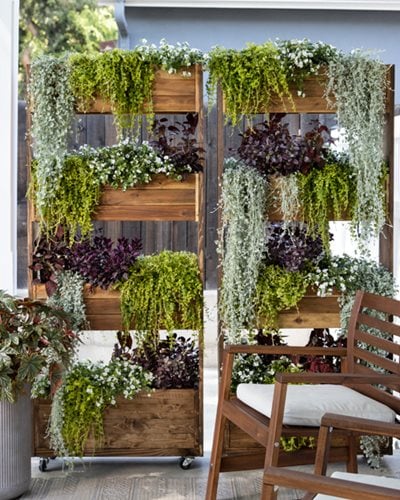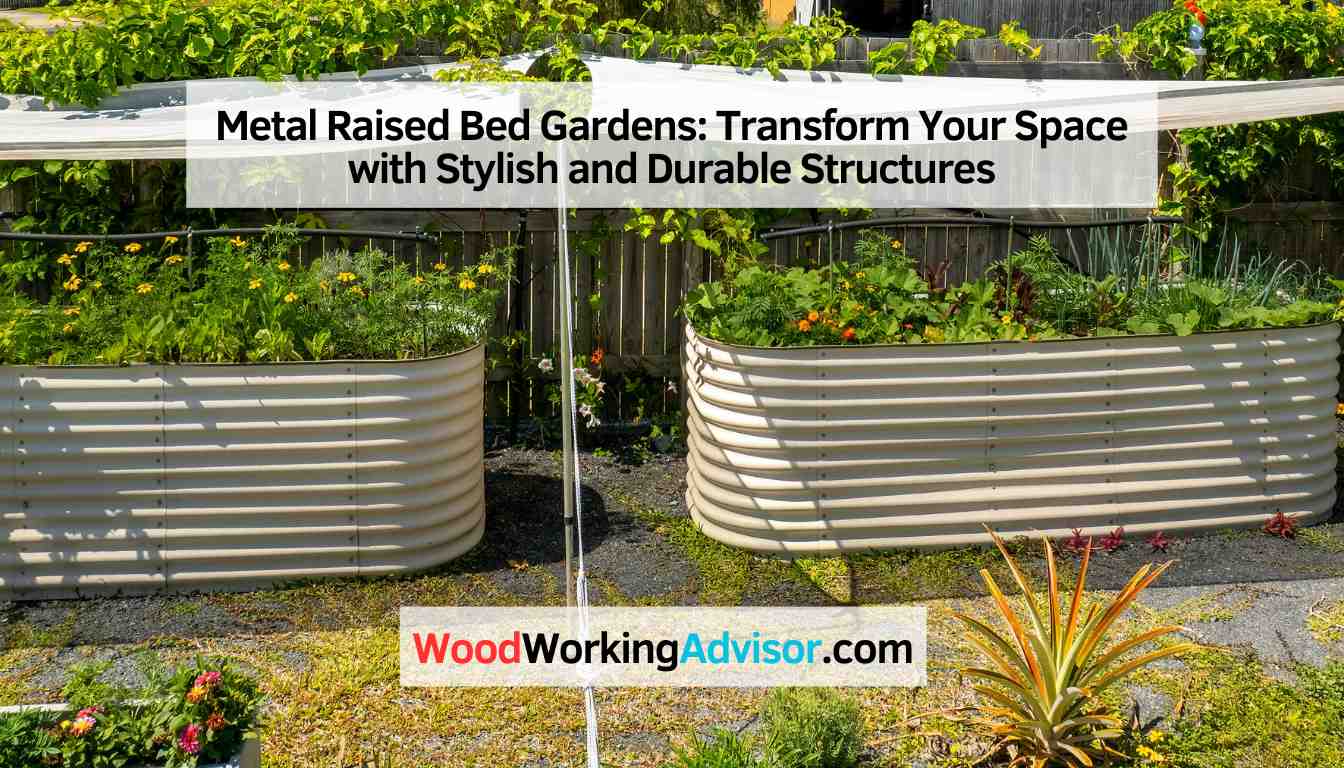Metal raised bed gardens offer durability and versatility for gardening in limited spaces. These beds, made from sturdy metal materials, provide a long-lasting growing environment for various plants.
Whether you have a small backyard or want to elevate your garden design, metal raised beds are a practical solution. The strength of metal ensures stability for your plants while also adding a modern touch to your outdoor space. With their sleek appearance and easy maintenance, metal raised bed gardens are a popular choice for gardeners seeking a reliable and stylish option.
These beds are customizable in size and shape, making them suitable for any gardening project, from vegetables to flowers.
:max_bytes(150000):strip_icc()/SPR-raised-bed-garden-ideas-4172154-hero-5d94244389e548e1ab545183230e7716.jpg)
Credit: www.thespruce.com
Benefits Of Metal Raised Bed Gardens
Metal raised bed gardens are a fantastic option for gardeners seeking a durable and stylish solution for their gardening needs. Let’s explore the advantages they offer.
Long-lasting And Durable
Metal raised bed gardens are built to stand the test of time, offering excellent durability and longevity. This ensures your garden beds will remain sturdy and functional for years to come.
Stylish And Modern Design
With their sleek and contemporary look, metal raised bed gardens add a touch of modernity to any garden space. Their design complements various outdoor aesthetics, creating a visually appealing environment.
Choosing The Right Metal For Your Raised Bed Garden
When selecting a metal for your raised bed garden, consider factors such as durability, cost, and aesthetic appeal. Corten steel offers a rustic look and long-lasting performance, while galvanized steel is budget-friendly and resistant to corrosion. Aluminium is lightweight and ideal for mobility.
Choose the right metal to suit your gardening needs and climate.
Metal raised bed gardens are durable and stylish options for your garden. Selecting the appropriate metal is crucial for long-lasting results. Here are some key considerations for choosing the right metal for your raised bed garden.
Steel Options
Steel is a popular choice for raised bed gardens due to its strength and durability.
– Cor-Ten steel is a weathering steel that develops a rust-like appearance over time, adding a rustic charm to your garden.
– Galvanized steel is coated with zinc to prevent rust, making it a low-maintenance option for your raised bed garden.
– Powder-coated steel offers a variety of color options to complement your garden’s aesthetic.
Aluminum Options
Aluminum is a lightweight and corrosion-resistant metal ideal for raised bed gardens.
– Anodized aluminum is treated to increase corrosion resistance and provide a sleek finish for your garden.
– Recycled aluminum is an eco-friendly option that reduces environmental impact while offering durability for your raised bed garden.
Consider the specific needs of your garden when selecting a metal for your raised bed. Each metal option offers unique benefits that cater to different preferences and gardening styles. Make an informed decision to ensure your metal raised bed garden thrives for years to come.
Design And Placement Considerations
When planning a metal raised bed garden, thoughtful design and strategic placement are key factors for its success. Considerations such as space utilization and visual appeal play a crucial role in creating an optimal environment for your plants to thrive. Here are some important design and placement considerations to keep in mind when setting up a metal raised bed garden:
Maximizing Space
Utilizing the available space efficiently is essential in metal raised bed gardens. Maximize planting area by utilizing vertical space with trellises and selecting compact vegetable varieties that thrive in tight spaces. Additionally, consider implementing tiered beds to make the most of limited space and provide adequate growing room for a variety of plants.
Aesthetic Appeal
To ensure an eye-catching aesthetic, carefully choose the location of your metal raised bed garden. Position it in a spot that harmonizes with the overall landscape, complementing the existing design of your outdoor space. Incorporating attractive edging materials and selecting an appropriate bed shape can further enhance the visual appeal of the garden.

Credit: www.gardendesign.com
Construction And Assembly Tips
Raised bed gardens offer a versatile and efficient way to grow your plants, and metal raised beds are an excellent option due to their durability and resilience. If you’re embarking on a project to construct and assemble your metal raised bed garden, here are some essential tips to help you get started:
Preparing The Site
Before you begin the construction process, it’s essential to prepare the site properly. Follow these steps to ensure your metal raised bed garden has a solid foundation:
- Clear the area: Remove any debris, rocks, and weeds from the site to create a clean and even surface.
- Level the ground: Use a shovel or garden rake to level the ground where your metal raised bed will sit. This will help with stability and drainage.
- Lay a weed barrier: To prevent weeds from growing up through the soil, lay a weed barrier fabric on the cleared and leveled surface. This will save you time and effort in the long run.
Tools And Techniques
Having the right tools and using the correct techniques will make the construction and assembly process smoother and more efficient. Here are some vital tools and techniques to consider:
Tools:
- Metal raised bed kit: Choose a kit that includes all the necessary materials, such as metal panels, corner brackets, and screws. This will save you time and ensure a proper fit.
- Power drill: A power drill with the appropriate drill bit will make installation faster and more precise.
- Level: Use a level to ensure your metal raised bed is even and balanced.
- Tape measure: Accurate measurements are crucial for a seamless assembly, so keep a tape measure handy.
Techniques:
Follow these techniques to ensure your metal raised bed is assembled correctly:
- Start with the corners: Begin by attaching the corner brackets to the metal panels. This will provide stability and structure.
- Secure the panels: Use screws to connect the metal panels to the corner brackets. Make sure each panel is securely fastened and level with the others.
- Add reinforcement: If desired, you can add extra support by including metal stakes or additional brackets along the sides of your raised bed.
- Fill with soil: Once assembled, fill your metal raised bed with high-quality soil, rich in nutrients, before planting your desired plants or vegetables.
By following these construction and assembly tips, you’ll be well on your way to creating a sturdy and beautiful metal raised bed garden. Enjoy the benefits of easy maintenance, improved drainage, and long-lasting durability for your plants!
Maintaining And Caring For Metal Raised Bed Gardens
Discover the key steps to effectively maintain and care for your metal raised bed gardens. Keep them rust-free with regular cleaning and consider applying a protective coating for longevity and durability. Proper upkeep ensures your garden beds remain functional and aesthetically pleasing.
Metal raised bed gardens are not only durable and long-lasting, but they also add a sleek and modern touch to any garden. However, just like any other garden bed, metal raised beds require regular maintenance and care to ensure their longevity and optimal performance. In this section, we will explore some key factors to consider when maintaining and caring for your metal raised bed gardens, including preventing rust and seasonal maintenance.
Preventing Rust
Rust can be a common issue with metal raised bed gardens, especially when they are exposed to the elements for an extended period. Fortunately, there are measures you can take to prevent rust and extend the lifespan of your metal beds.
1. Proper drainage: Ensure that your metal raised bed has good drainage to prevent water from accumulating and causing rust. You can achieve this by adding a layer of gravel or small stones at the bottom of the bed before adding soil.
2. Use a protective coating: Applying a protective coating, such as a rust-preventing paint or a clear sealant, can provide an extra layer of protection for your metal raised bed. Be sure to choose a coating that is suitable for outdoor use and follow the manufacturer’s instructions for application.
3. Avoid contact with moisture: Metal raised beds are prone to rust when in direct contact with moist soil or standing water for prolonged periods. To prevent this, consider using a liner, such as plastic or landscape fabric, between the soil and the metal bed.
Seasonal Maintenance
To keep your metal raised bed gardens in top shape throughout the year, consider these seasonal maintenance tasks:
1. Cleaning: Before each growing season, take the time to clean your metal raised beds. Remove any debris, weeds, or fallen leaves that may have accumulated during the winter months. This will help prevent pests and diseases from spreading.
2. Inspect for wear and tear: Regularly inspect your metal raised beds for any signs of wear and tear, such as loose joints or rust spots. Address any issues promptly to prevent further damage and ensure the longevity of your beds.
3. Replenish soil nutrients: Over time, the soil in your metal raised beds may become depleted of essential nutrients. Before each planting season, consider amending the soil with organic matter, such as compost or well-rotted manure, to replenish the nutrients and promote healthy plant growth.
By following these preventative measures and performing seasonal maintenance, you can ensure that your metal raised bed gardens remain in optimal condition year after year. With proper care, your metal raised beds will continue to provide a beautiful and functional space for your plants to thrive. Happy gardening!
Frequently Asked Questions On Metal Raised Bed Gardens
What Are The Benefits Of Using Metal Raised Bed Gardens?
Metal raised bed gardens offer several benefits, including improved drainage, better soil quality control, longer lifespan compared to wood, and resistance to pests and rot. They also provide a stylish and modern look to your garden, adding value to your outdoor space.
How Do I Choose The Right Size Of A Metal Raised Bed Garden?
When choosing the size of a metal raised bed garden, consider the available space in your garden, the number and types of plants you want to grow, and your own physical capabilities for tending to the garden. Generally, selecting dimensions of 4 feet wide by 8 feet long and 12 inches deep allows for easy access and efficient gardening.
Can I Use A Metal Raised Bed Garden For Growing Vegetables?
Yes, metal raised bed gardens are excellent for growing vegetables. They provide the necessary depth for root development, good soil drainage, and protection against ground-dwelling pests. Just make sure to choose a metal that is safe for growing food, such as galvanized steel or food-grade aluminum.
Are There Any Disadvantages To Using A Metal Raised Bed Garden?
While metal raised bed gardens offer numerous benefits, there are a few potential drawbacks to consider. Metal can heat up quickly in the sun, which may affect plant roots. Some metals, like aluminum, can react with acidic or alkaline soil, altering its pH.
Additionally, metal can be more expensive compared to other materials like wood or plastic.
Conclusion
Metal raised bed gardens are a versatile and durable option for cultivating thriving plants. With their numerous benefits, such as longevity and easy maintenance, they are a worthy investment for any garden enthusiast. Enhancing both the functionality and aesthetics of your garden, metal raised beds offer a practical and stylish solution for growing a variety of crops.


